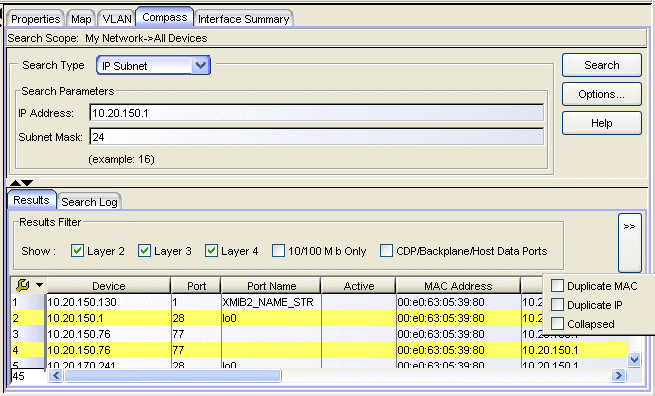IP Subnet Search
The IP subnet search on the Compass tab enables you to search for the members of a specified subnet (including multicast addresses) within the device(s) or device group(s) selected in the left panel. The IP subnet search looks at the following tables:
|
|
To access the IP Subnet search on the Compass tab, select the desired device(s) or device group(s)
in the left panel, and select the Compass tab in the right panel. Then select the
IP Subnet Search Type from the drop-down list. If the
bottom section of the Compass tab containing the Results and Search Log tabs is
not visible, click the panel control up button
![]() at the foot of the tab.
at the foot of the tab.
Click areas in the window for more information.

- Search Scope
- The scope within which the search will be performed, based on the device(s) or device group(s) selected in the left panel.
Search Parameters
Compass performs the search on the device(s) or device group(s) selected in the left panel (the Search Scope). To search for the members of a subnet within the scope selected in the left panel, enter an IP address from the subnet in the IP Address text field, and enter a network mask value which defines the subnet group. To start a search, click Search. You can stop the search at any time by clicking the Stop button.
- IP Address
- Enter an IP address from the subnet you want to search. Compass will look for the members of the subnet within the selected scope.
- Subnet Mask
- When you click this text box, it defaults to the natural network mask value, unless you enter a different one. The format of this text box depends on the format selected for the Suite-Wide Data Display Network Mask option in the Tools > Options window: either CIDR or dot-delimited. An example of the selected format is provided below the text box.
Search Log Tab
This tab displays a log of the progress of the search and notifies you of unsupported devices. See Search Log Tab for more information.
Results Tab
This tab displays the results of the Compass search in table form. See Results tab for the table capabilities, and the other right-click menu options offered on this tab.
- Device
- This column lists any device which is aware of the IP subnet. For example, the network element associated with the IP subnet may be connected to this device, or it may have contacted this device, or this device may be on the path to a device the network element contacted.
- Port
- Port number of the port which is aware of the network element's IP subnet. The network element may be connected to this port.
- Port Name
- Port name of the port which is aware of the network element's IP subnet. The network element may be connected to this port.
- Active
- The checkmarks in this column indicate the entries with the most relevant information. Entries are considered Active if they exist in the 802.1X MIB, PWA MIB, dot1dTpFdb table or the dot1qTpFdb table. To display all the Active entries together, click the Active column header to sort the entries.
- Address
- Address (IP, UDP, etc.) of the network element. The next field (Address Type) tells you what type of address this is.
- State
- Current operating state of the network element. Possible values are:
-
State Meaning initialize an initialize is in progress returning the port to an initial state active connection is active inactive, connection is inactive disconnected, no user is logged in. authenticating a login is in process and has not yet completed authenticated a user has successfully logged in held the port is locked down because the number of failed login attempts has exceeded the allowable limit. connecting connection in process aborting indicates an authentication timeout forceAuth the port is always authorized forceUnauth an administrator has terminated the user session authSuccess means authentication was attempted and succeeded authTerminated a session was active or in progress and was subsequently terminated <blank>. State was not retrieved
For information on related tasks:
For information on related windows: